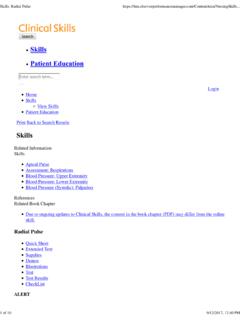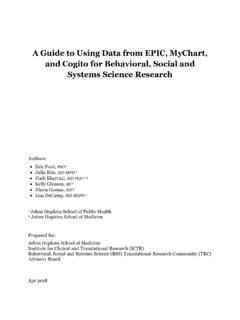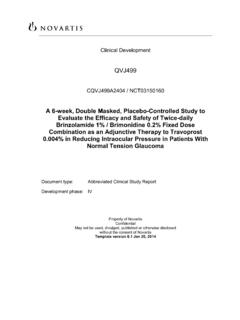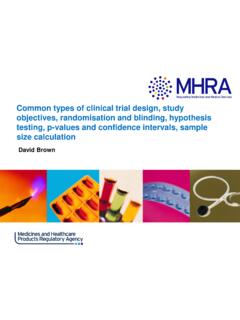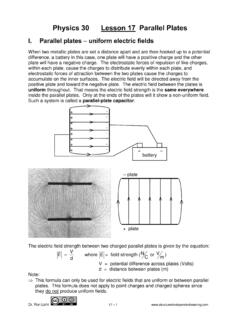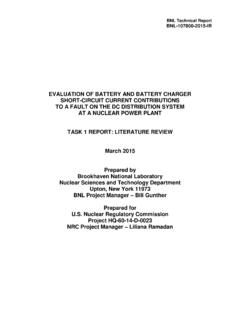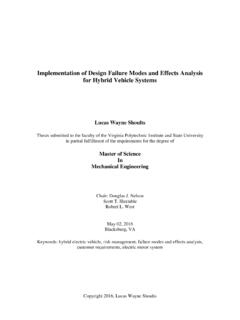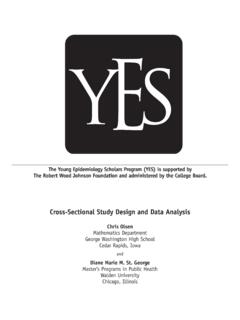Transcription of An Introduction to Clinical Trials: Type of Studies Design ...
1 An Introduction to Clinical Trials: Design IssuesEdgar R Miller III PhD, MDWelch Center for Prevention, Epidemiology and Clinical ResearchJohns Hopkins UniversitySchool of Medicine and Bloomberg School of Public Health2 Type of Studies Non-experimental (Observational) Case report Case series Cross-sectional (survey) Case-control Prospective, observational (cohort) Experimental Randomized, Clinical trial (RCT) 3 study designs Observational Studies : Observeboth exposures and outcomes Experimental Studies ( Clinical trials) Assignexposures Observeoutcomes4 Advantages of Clinical Trials Often provides the strongest evidence in support of cause-effect relationships Basis for Clinical and public health policy Minimize/eliminate bias and confounding5 Randomized Clinical TrialTarget PopulationStudy PopulationRANDOMIZEDS tandard TreatmentNew TreatmentDiseaseDisease6 Comparison of study Designs Type of study Design Dimension Cross-Sectional Case-Control Cohort RCTE stimate Prevalence A - B - Estimate Incidence - - A B Prove Causality C B- B+ A Generalizability A B+ B+ B Feasability A A B C
2 7 Core Elements of a Clinical Trial Research Question Hypotheses Core Design study Participants Recruitment Allocation Masking (Blinding) Treatment Groups Data Analytical Issues Interpretation of Results8 The Research Question Critical in the Design of a trial Types of questions: Assessing efficacy of an intervention Assessing the effectiveness of an intervention9 Types of Hypotheses Comparative Trial ( Superiority Trial) Objective: to demonstrate that a new therapy (n) is superior to standard therapy (s) in terms of incident outcome (I)HO: In= IsHA: In< Is (one tailed) or HA: In Is (two tailed) at some minimally detectable judged to have Clinical significance10 Types of Hypotheses Equivalence (non-inferiority trial) Objective: to demonstrate that a new therapy (n) is no worse than standard therapy (s) in terms of incident outcome (I) HO: In> IsHA: In= Is at some , the maximum tolerable difference considered to be clinically acceptable11 Basic Types of DesignParallelCross-OverA A A BBBP arallel study Design (PREMIER)ADVICE ONLYESTEST + DASHR andomizationPrimary Outcomes (6 months)End of Intervention (18 months)= Data Visit-12-10-8-6-4-2024 Baseline1234567 and 8 Control Diet Fruits-and-vegetables Diet DASHI ntervention Week**Conlin et al.
3 , Am J Hypertens, 2002 Cross-Over study Design (OmniHeart)Period 16 weeksPeriod 26 weeksPeriod 36 weeksRandomization to 1 of 6 sequencesWashout Period2 4 wkWashout Period2-4 wkData:Run-In6 daysParticipants Ate study FoodScreening/BaselineParticipants Ate Their Own FoodBlood Pressure Results (mmHg)Mean Change from Baseline in Each DietSystolic Only et al. 200516 Usual DietUsual DietRandomization to DietRun-in (11-14 days)Intervention (three 30-d periods in random order)Intermediate SodiumLower SodiumHigher SodiumLower SodiumIntermediate SodiumHigher SodiumDASH DietMixed study Design (DASH-Sodium)Randomized SequenceEffect of Increased Sodium Intake on Systolic Blood Pressure in Two Diets: Results of the DASH-Sodium Trial*120125130135 SystolicBlood PressureAmerican DietDASH Diet65 100 140 Approximate Daily Sodium Intake (mmol/day) + + + + + <.
4 0001+ <.0001*Sacks et al, 200118 Factorial Design Type of trial in which individuals are randomized to two or more therapies ( example : Physician s Health study : tested aspirin (ASA) and -caroteneNeither -carotene onlyASA onlyBothNo -carotene -carotene No ASAASA10,00010,00010,000 10,000 20,000 The African American study of Kidney Disease and Hypertension (AASK)AASK Research QuestionsAmong African-Americans with early evidence of hypertension-related kidney disease: Does aggressive blood pressure control to a target blood pressure below current recommendations retard the progression of kidney disease? Do specific classes of anti-hypertensive medications retard the progression of kidney disease? Design of AASK Randomized, active controlled trial with a 2 x 3 factorial Design Participants: 1,094 African-Americans with hypertension-related renal insufficiency Planned follow-up of to 5 years Treatment Assignments (2:2:1 ratio of drug assignment)3 X 2 Factorial DesignN 441 436 217 MAP = Mean Arterial Pressure; * = referent group Metoprolol* Ramipril Amlodipine MAP <92 20% 20% 10% MAP 102-107 20% 20% 10% 23 Mean Arterial Pressure During Follow-upLower BP Goal (Achieved: 128/78)Usual BP Goal (Achieved: 141/85)MAP (mm Hg)8090100110120130 Follow-up Month0 41220283644526024RR=Risk Reduction, adjusted for baseline covariates% with EventsComposite Clinical OutcomeDeclining GFR Event, ESRD or DeathLow vs.)
5 Usual:RR=2%, (p= )Lower BP (Achieved: 128/78)Usual BP (Achieved: 141/85)0510152025303540 Follow-Up Time (Months)0612182430364248546025 Main Clinical Composite OutcomeDeclining GFR Event, ESRD, or Death%with EventsMetoprolol vs. Amlodipine:RR= 20%, p= Ramipril vs. Amlodipine: RR= 38%, p= MetoprololRamiprilAmlodipine051015202530 3540 Follow-up Month06121824303642485460RR = Risk ReductionRamipril vs. MetoprololRR = 22%, p = = Risk Reduction, Adjusting for Baseline Covariates27 study ParticipantsTarget PopulationAccessible PopulationStudy Samples28 study Participants: example Target Population -> Healthy Elderly Accessible Population -> Retired Teachers study Sample -> Volunteer Teachers who respond to mass mailing29 study Participants Ideal Accessible Population high risk for disease candidates for treatment representative of target population feasibility considerations recruitment follow-up high quality data30 Enrollment Criteria Inclusion Criteria characteristics of accessible population Exclusion Criteria considerations related to.
6 Adherence to therapy follow-up safety ethics31 Common Recruitment Strategies General mailings Licensed drivers Voters Employee paychecks Targeted mailings HMO enrollees AARP members Mass media Radio TV ads Newspapers Posters/flyers Screenings Worksite Community Physician Referral Medical Record Review Internet / WWW Clinical trial registries Banner ads Social networks32 Comments on Recruitment Recruitment begins with Design Response rate is always lower than expected Required resources are more than expected Dedicated personnel are necessary33 More Comments on Recruitment Recruitment period is often longer than expected Implement several strategies to identify best source Prepare back-up strategies Monitor recruitment Early Often Locally34 Recruitment Funnel ( example : VITAL Pilot study )4,774 Mailed Invitations2,034 Questionnaires Returned765 Interested After Initial Mailing323 Randomizable after Second Mailing (7% cumulative)297 Randomized43%38%41%35 Allocation Random stratified blocked Non-Random haphazard systematic36 Why randomize?
7 Two critical reasons: to eliminate selection BIAS to reduce/avoid CONFOUNDING from known and, more importantly, unknown confounders37 Masking (Blinding) Single Blind Observers (persons who collect outcome variable) do not know treatment assignment Double Blind study participants AND observers do not know treatment assignments Triple Blind Data interpreters, study participants, and observers do not know treatment assignments 38 Masking (Blinding)Single MaskedDouble MaskedTriple MaskedOutcome Assessor(s)XX XParticipantXXData InterpreterX39 Selection of Groups Active Treatment Group Comparison Group Placebo (no active therapy) Usual care (referral back to personal MD) Active control group (provision of standard therapy)40 Problems with selecting active treatment group Many Candidate treatments observation Studies , animal models, or theoretically based Strong evidence rarely exists to guide selection of intervention Dose/intensity are uncertain41 Comparison Group Placebo used in setting of: No standard therapy OR Standard therapy but risk of not providing it is minimal Usual care OR active control common 42 Problems with standard of care approach Efficacy of Usual care often not tested Variations in standard of care are common.
8 Across providers between experts and providers secular trends occur43 Data Baseline data Determine eligibility Describe study participants Define subgroups Address confounding Measures of Adherence Outcome Variables44 Outcome Variables Principal outcome most important variable after randomization code specified in hypothesis determinant of sample size Secondary Outcomes relevant to research question45 Desirable Features of Outcome Variable clinically relevant easy to measure little measurement error random error leads to imprecision systematic error leads to bias masked (blinded) ascertainment46 Surrogate Outcomes Definition: a laboratory measurement or physical sign used as a substitute for a clinically meaningful outcome Types: physiologic variable, Clinical risk factor, or sub- Clinical disease47 Advantages of Surrogate Outcomes Surrogate outcomes typically increase statistical power compared to Clinical outcomes Surrogate outcomes often continuous measured repeatedly Clinical outcomes often categorical surveillance till outcome occurs48 Advantages of Surrogate Outcomes (continued) Enhanced power means shorter duration of follow-up and/or reduced sample size less cost Less contamination by competing comorbidities if the study duration is short Useful in Studies of mechanisms Surrogate and Clinical outcomes: a continuumTo t a l MortalityCause-Specific MortalityMorbid EventsEstablished Risk FactorAntecedent of the Risk FactorSurrogate and Clinical outcomes.
9 An exampleTo t a l MortalityCVD MortalityMIBlood PressureWeightAnginaRelationship between Surrogate and Clinical OutcomesSurrogate OutcomeRelationship between Change in Surrogate Outcome and Change in Clinical OutcomesChange in Surrogate OutcomeClinical and Surrogate Outcomes: CardiovascularClinical SurrogateStrokeUltrasound measurement of intimal medial thickness of the carotid artery Blood pressureMyocardial infarctionQuantitative coronary angiographyElectron beam computerzied tomographySudden deathVentricular arrhythmia Heart failure Ejection fractionWeaknessesDisadvantages of Surrogate Outcomes Measurement of surrogate outcomes can involve complex, technical procedures procedures sometimes new (therefore, longitudinal data is scant) procedures become obsolete many technical and analytic issues, often unapparentDisadvantages of Surrogate Outcomes (continued) Missing values are commonplace Missing values result from loss to follow-up and poor quality of data Potential for bias missing values occur in the sickest people, sometimes because of the Clinical outcome of interest informative censoring, that is, loss of follow-up data potentially related to treatment assignmentModels for success and failure of surrogate outcomes**Fleming TR, DeMets DL.
10 Surrogate End Points in Clinical Trials: Are we being mislead? Ann Int Med 1996;125 for potential success: Surrogate outcome in the casual pathwayDiseaseSurrogate OutcomeClinical OutcomeInterventionTimeModel for potential success: Surrogate outcome in the casual pathwayHypertensionBlood PressureStrokeDiureticsTimeModel for failure: the surrogate is not in the causal pathway of the disease processSurrogate OutcomeClinical OutcomeDiseaseInterventionModel for failure: the surrogate is not in the causal pathway of the disease process Bone DensityfracturesOsteoporosisFluorideDise aseSurrogate OutcomeClinical OutcomeInterventionModel for failure: the intervention affects only the pathway mediated through the surrogateKidney Damage ProteinuriaKidney FailureProtein RestrictionModel for failure: the intervention affects only the pathway mediated through the surrogateModel for failure: The intervention has several mechanisms of actionSurrogate OutcomeClinical OutcomeInterventionDiseaseExample: Dihydropyridine calcium channel blockersBlood PressureMyocardial InfarctionCalcium Channel BlockersASCVD+_The Cardiac Arrhythmia Suppression Trial (CAST*): Background Ventricular arrhythmias are a risk factor for sudden death after MI Four fold higher risk of cardiac mortality among persons with frequent premature ventricular contractions (PVCs) In the CAST pilot study , the antiarrhythmic drugs (encainide, flecainide) suppressed PVCs*Echt DS et al.

